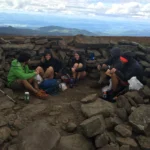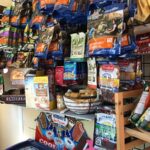Hiking-Friendly Foods
Thoughtful planning of your food and water is key for an enjoyable time on the Appalachian Trail.
If you’re out for the day or the weekend, you can probably pack whatever foods you like best, including fresh fruit or a deli sandwich with the works. But since these items spoil quickly or are heavy due to their high-water content, they’re not good for extended backpacking trips.
Most backpackers look for calorie-dense, lightweight food that does not spoil and can be easily packed into a bear canister or stuff sack. You may also consider looking for “durability” in your food, that is, food that can handle being tossed around and compressed a bit.
Hiking Breakfast Ideas
- Instant oatmeal or grits
- Powdered milk
- Breakfast cereals that won’t crush easily
- Toaster pastries like Pop Tarts
- Energy or granola bars
ATC staff breakfast tip: Mixing instant coffee packets with a packet of vanilla powdered breakfast drink mix, like Carnation, creates a tasty backcountry latte! Bonus points if you use the high protein version.
Hiking Lunch Ideas
- Crackers and cheese (hard cheeses like cheddar keep well, especially in cool weather)
- Cured meats like salami or pepperoni
- Tuna or chicken in foil packets in tortillas, pita bread, or bagels
- Peanut butter, nut butters and other spreadable items like Nutella on those same tortillas/pita bread/bagels
ATC staff lunch tip: You can get individual mayonnaise or mustard packets at most gas stations or grocery stores for added flavor.

Hiking Dinner Ideas
- Instant pasta or rice
- Instant mashed potatoes
- Mac & cheese
- Freeze-dried meals like ReadyWise (bonus: proceeds from some of ReadyWise’s meals go to the ATC!)
- Adding dried veggies and/or tuna or chicken in foil packets are lightweight ways to add flavor and protein to your dinners.
ATC staff dinner tip: Always carry an extra dinner in case of emergency. Something cheap and lightweight, like a packet of ramen, could be the difference between a hot meal and a hungry night stuck in the woods.
Hiking Snacks
- Carry lots of snacks, including things you can nibble while you’re hiking. You’ll have more energy if you snack often compared to if you eat only big meals. Some good trail snacks include:
- Energy bars and granola bars
- GORP (granola, oats, raisins and peanuts). You can make your own and add whatever mix-ins you like!
- Nuts and dried fruit
- Candy

Food to Avoid While Hiking
There are no hard and fast rules for what to carry and what not to carry; we’ve seen A.T. hikers carrying sticks of butter, fresh veggies and fruit, and even whole take-out meals!
However, novice backpackers on the A.T. often make the mistake of carrying too much food or food that is heavy. An overly heavy, bulky pack can take the fun out of backpacking. Here are some guidelines for beginners until you get in your backpacking groove:
- Avoid canned foods or foods high in water weight.
- Avoid bulky foods that take up a lot of space and food that can get crushed easily. For example, opt for tortillas over bread.
- Avoid food in glass jars. Pick something else or put the food in a plastic bag or plastic container.
- Repackage bulk food items. For example, put condiments into a small travel shampoo bottle instead of carrying the whole jar. Split big tortilla packets into just what you need for your hike. There’s no need to carry food that you won’t get to eat!
How Much Food Should You Carry?
Backpacking burns a lot of energy and staying well-nourished will help you avoid injury, illness, and make your trip more fun. Look at your guidebook or map to determine how many days you’ll be on the Trail or how many days it will take you to get to your next resupply point. Beginner backpackers should plan on hiking 8-10 miles a day.
Daily Food Needs
1.5 to 2 pounds of food per day to start can be adequate in most circumstances if your food is high in calories. If you are doing big miles (above 15) or are in rugged terrain with a lot of elevation gain you may need more. You’ll also need to carry more food in winter.
Long-Distance Hiking
On a long-distance hike (longer than a week or two) you will develop a bigger appetite and may need to carry more as your hike progresses. However, you’ll also get better at knowing exactly how much to carry the more you hike.

Emergency Food
Always carry an emergency dinner and snack in case you are delayed. This is especially important in winter, spring, and late fall when weather is especially unpredictable.
Carry extra food and supplies in New Hampshire and Maine, especially through the 100 Mile Wilderness, in case you are delayed or have to turn around due to high water at river crossings.
Again, what you carry comes down to preference and dietary needs.
Sample Backpacking MenuThinking of Doing Some Trail Magic?
More people are visiting the A.T. specifically to provide food and drinks for thru-hikers or to host “hiker feeds.” Unfortunately, the ATC and our partners have started to see unintended negative impacts to the Trail due to the popularity of this kind of “trail magic.”
Read through our trail magic guidelines to learn how to best support both hikers and the Trail we all love.
Trail Magic Tips
Jason Bushnell
Resupply Strategies
Backpackers who are on trips that last longer than 4 –7 days resupply along the way at grocery stores and outfitters, buy food ahead of time and have it shipped to them, or a combination of the two.
Buying Food at Grocery Stores
Also called “on-Trail resupply,” this is a popular strategy for many thru-hikers because of the relative ease of getting in and out of town on the A.T.
Advantages to Grocery Stores:
- Many hikers feel that this strategy gives them the greatest flexibility with their meal planning — they can change their meals based on what they crave or get sick of eating.
- Many Trail towns have large, full-service grocery stores, and almost all have at least a small general store, discount food store, or outfitter that carries backpacking food.
- Most lightweight backpacking staples can be purchased at a grocery store. You need not rely on expensive, prepared “backpacking food” sold at camping stores, although these products can offer convenience and variety.

Tips for Success Shopping at Grocery Stores:
- Be sure to look ahead at what services are available in the towns you’ll pass through to determine whether an on-Trail resupply will work.
- Small Trail towns with only a general store won’t have a wide variety of foods available. General stores and outfitters tend to be more expensive for resupply than large chain grocery stores, too
- There are still a few spots where most hikers mail a resupply box due to a lack of easily accessible grocery stores. These include Fontana Dam, Harpers Ferry, and Monson, ME.
- Many thru-hikers will also have to mail themselves at least one or two resupply boxes for replacement gear at some point on the Trail.
What is a Bounce Box?
A bounce box is a resupply box with miscellaneous gear and supplies that a hiker may need at different points in their trip. It could have warmer gear, replacement shoes, a new water filter, medications, etc. It’s called a bounce box because, so long as the box is not accepted and opened, it can generally be forwarded to the next town at no cost. It “bounces” up the Trail ahead of you.
Bounce boxes are sent via U.S. Postal Service and should be sent by priority mail so they can be forwarded if unopened.
Mailing Resupply Boxes
Some hikers still prefer to buy all or most of their food ahead of time and have boxes of the food mailed to them along the Trail.
Advantages to Resupply Boxes:
- This is a great strategy for people with a limited budget since they can buy their food in bulk or prepare and dehydrate their own food.
- This is also a great strategy for people with dietary restrictions who are concerned that even larger grocery stores along the Trail will not have the variety they need. While there are downsides, like less flexibility in your meals and the cost of shipping, there are thru-hikers each year who use this strategy for the whole trail.

Tips for Success Mailing Your Resupply Boxes:
- Pick a trusted family member or friend to be your resupply support. This will be the person you contact when you need a box mailed to you.
- Organize your food at home ahead of time into categories like breakfast, lunch, dinner, snacks, etc. This will help your support person make sure you get the food you want when you need it.
- Further organize your food by repackaging it and portioning it out.
- Unless your guidebook specifically says that a business accepts hiker packages, call ahead to check before sending a box there.
- Avoid sending resupply boxes to post offices if you can. Many small-town post offices have limited hours and post offices are closed on weekends, which can delay you if you arrive on a Saturday or Sunday.
- Write “Hold for Hiker: YOUR NAME” on multiple sides of the box.
To address a resupply box to a business:
HIKER NAME
c/o BUSINESS NAME
Street Address
City, State Zip Code
Hold For Hiker
To address a resupply box to a post office:
HIKER NAME
c/o General Delivery
Street Address of Post Office
City, State Zip Code
Hold for Pickup
Cooking on the A.T.
Don’t rely on campfires for cooking.
- Campfires are one of the biggest human-driven impacts on the Trail and surrounding environment. Forgoing a campfire helps minimize your impact.
- Campfires are only allowed in some sections of the Trail. Fires are often not allowed on many sections north of Shenandoah National Park.
- Even where campfires are allowed, burn bans could temporarily restrict them. Camp stoves with an on/off valve are generally allowed under burn bans.
- Backpacking stoves are more convenient and reliable in wet weather.
- Most hikers are too tired at the end of a long day of hiking to build a fire.
If you plan to cook, bring a backpacking stove with an on/off valve.

Pack Out All Food Waste
- Pack out all your garbage and food waste, including items such as apple cores and orange peels as these do not decompose quickly and attract wildlife, like bears.
- Don’t burn garbage in a campfire; it rarely burns completely and may produce harmful fumes. It can also attract wildlife.
- Don’t throw garbage or food waste in the privy. It does not decompose, can attract wildlife, and then must be packed out by a volunteer.
- Keep a clean camp by cleaning up all spills and crumbs. This helps keep mice populations down at shelters and keeps other wildlife away, too.
- If you have gray water (leftover cooking water, like from cooking pasta), be sure to strain all food bits out of it before scattering it at least 200 feet (70 big steps) from campsites, water sources, and trails. Some overnight sites may even have a dedicated gray water pit.






